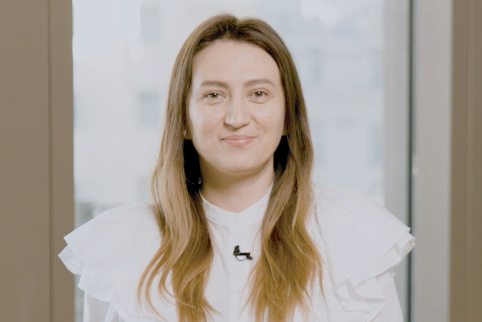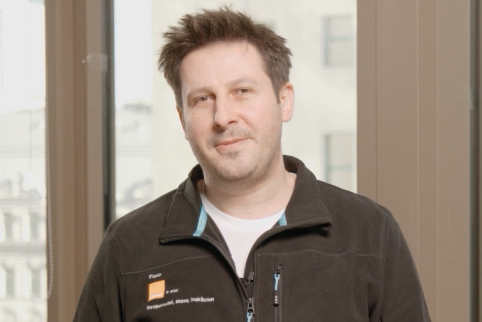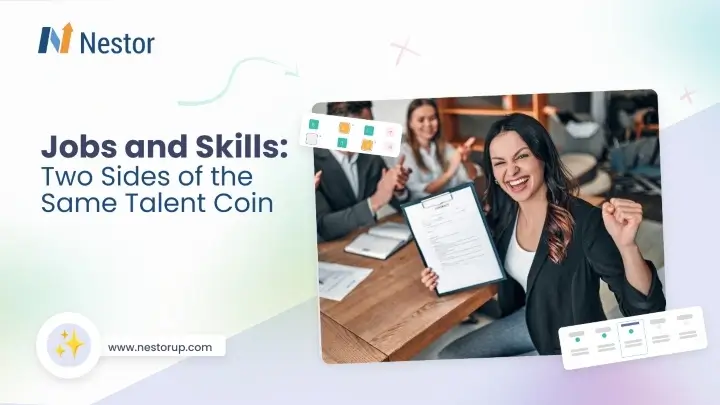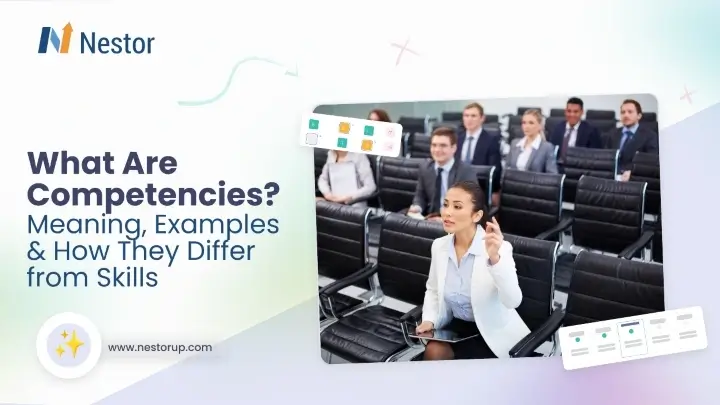
As jobs constantly evolve, they demand new skills, different from the ones of the pre-pandemic world. This makes the “war for talent” more fierce than ever. The good news is that many of the top skills in fast-growing and higher-paying roles are similar to skills in other fields.
For example, as seen in the picture below — according to LinkedIn research — a cashier has a 70% skills match with a customer service representative. Therefore the cashier has some transferable skills that will help them reskill for another position but they will also need to acquire new types of skills to make a great fit.
With the right technology and a skills-based approach, it’s easier to match talent to opportunities existing in the company or in the market, regardless of past education or certifications which in today’s world might be obsolete anyway.
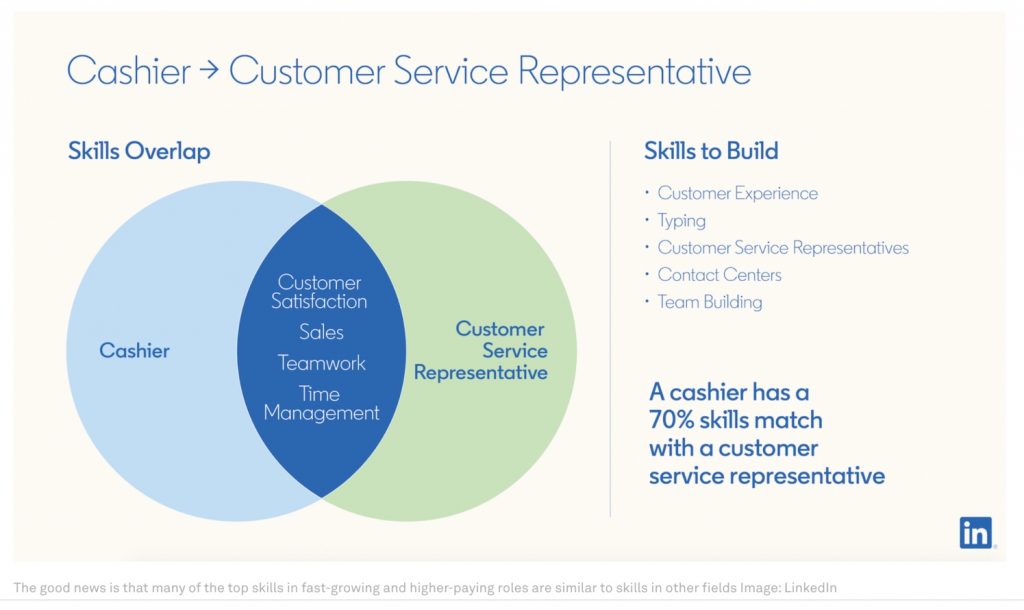
But to consider skills as the foundation for hiring or talent development, skills taxonomies are a necessary first step to structuring information. A skill taxonomy allows the company to organize and further assess the required competencies and skills, necessary to perform certain functions, job roles, or projects.
However, the part we tend to pay less attention to is that skills taxonomies should equally focus on technical skills – traditionally referred to as hard skills but also on soft skills – those types of skills that have become particularly important to succeed in today’s environment.
Why do soft skills suddenly matter so much?
The most in-demand skills aren’t just about staying ahead of technology, or performing your daily tasks, not anymore. Skills related to adaptability, teamwork, leadership, digital communication, and learning agility have become critical to both individual and organizational performance.
Considering the latest changes in the nature of our work, how we are working and the new type of jobs arising, these skills are essential for succeeding in the modern workplace and building resilient teams. As businesses continue to navigate the challenges of the pandemic, strong leadership skills are essential for motivating teams, keeping their morale high, and fostering belonging. Moreover, leadership development becomes imperative for the workforce at all levels, from the top way down not only for the C-level executives or the middle management.
According to LinkedIn’s 2019 Global Talent Trends report, 89% of recruiters say that the lack of soft skills in a candidate profile indicates a potential miss-hire. Deloitte Access Economics forecasts that soft skill-intensive occupations will account for two-thirds of all jobs by 2030, compared to half of all jobs in 2000.
The number of jobs in soft-skill-intensive occupations is expected to grow at 2.5 times the rate of jobs in other occupations. That’s a big workforce change, similar in magnitude to other major trends, like the shift from “blue-collar” to “white-collar” work, and the growing participation of women in the workforce.
The Nestor platform helps you identify the soft skills that matter the most
Soft skills are increasingly important for thriving in the modern workplace but how can we tell which soft skills matter the most? In an increasingly tech-enabled world, a People Intelligence Platform like Nestor gives you the support you need to collect capabilities and skills, map them around job roles and departments and gain visibility of skills at the organizational level with the help of a soft skills taxonomy.
A clear overview of the skills available helps managers identify any skills gaps that might affect business in the short or long term. It also supports organizations in efficiently using existing skills to redeploy talent fast, plan for future recruitment, or guide learning and development programs.
On top of that, we harness the power of data to measure and drive insights about how values, behaviors, or soft skills are distributed inside your organization and what are the existing gaps.
Based on these insights, the HR professionals and the people managers can further help people in their teams seize all growth opportunities specific to their needs and develop those soft skills that will help them advance in their careers. They can also spot if the member of a team ranks below the average compared to other peers for certain competencies or soft skills.

Steps in building a soft skills taxonomy: understanding the context and people’s capabilities
Decide which type of skills you want to collect
The first step is to decide on the type of skills you want to include in your skills taxonomy based on your organization’s strategy. For example, you can categorize these skills into areas such as leadership skills or behavioral skills. Consider dimensions like – mental, emotional, spiritual, physical, or digital.
The skills listed in the library should be relevant, future-fit, and appropriate for the tasks employees need to perform.
If you’re not sure how a soft skills taxonomy could be useful for your organization, start with a small iteration, usually for one department or a few teams.
Enforce a common language
Within any company or department, the employees have different levels of expertise that will vary over time. In an application like Nestor, you can set up the required proficiency level for each skill on a scale from 1 to 5. The information will be displayed for each employee profile. Moreover, managers can suggest skill proficiency levels for their direct reports.
Make people part of the process
With the right tools, organizations can collect insightful data in an easy and fun way by engaging people in the process. Based on their activity, people can send suggestions for new critical skills and make recommendations for other peers as well. This way, people can actively contribute to building a soft skills taxonomy and at the same time take the opportunity to reflect and self-discover.
Empower managers with the right tools and insights
Technology plays an important role in activating managers to take ownership of their team outcomes. The more they know about their people, the better they can act in the moment to help their direct reports grow. Managers know best the mission of their teams and the contribution of each individual, so empower managers in gathering critical skills for their teams.
Assess your current capabilities and seniority levels
Learning where you are, comes from data, and assessing the skills you’ve decided on is critical to see where your organizational capabilities stand. Here are some of the methods that can help you assess the current skills you have in the organization:
- Pulse surveys: Ask your employees some behavioral questions and let the technology infer skills based on the data collected.
- Self-assessment: Allow employees to rate their skills and knowledge for themselves. A self-assessment is a great tool to use because it approaches the skills inventory from a self-perspective. Employees can also express which skills they want to work on improving.
- 360 feedback/reviews: Get a holistic view of an employee’s skills and knowledge. Co-workers, managers, and any direct reports can provide feedback on an employee’s skill levels and give a good sense of how they are performing compared to the expectations of the job.
Link skills to learning and performance
Soft skills taxonomies ensure that people’s capabilities and skills are aligned with the ongoing business needs. This alignment is what creates value for organizations and makes them competitive in the market.
Learning & Development: Identify and assign the most suitable learning opportunities that will develop your employees and help them advance in their careers, whether it’s a lateral move inside the organization, a manager role, or a higher position.
Performance goals: Make sure that people’s activities, goals, and objectives (including KPIs and OKRs) match their skills and competencies. Assign development goals that can influence the operational goals and make sure skills can be trained or developed by practice.
Keep your soft skills taxonomy alive and update it in an ongoing way from all relevant resources available
Other sources you might consider to keep your soft skills taxonomy database relevant and alive involve open collaboration with other industry experts, research organizations, industry-related associations, or other open libraries such as O*NET or ESCO.
You can either interview them or do your own research from various publications or sources available online. You can also tap into data gathered from professional social networks like LinkedIn or job postings to identify high-demand soft skills.
Whatever source you choose, always keep in mind your business goals. Even if you might discover new skills that aren’t yet included in your database, they first need to match your business needs and goals and be relevant to your organization and the industry you are operating.
Match talent with the right opportunities and drive change at scale based on the data collected
Soft skills taxonomies should not be the end goal but rather the starting point for future-proofing your workforce.
With a clear picture of both actual and desired skills and proficiency levels, companies can address existing competency gaps so that managers can create and assign development goals for employees, and initiate learning and mentorship programs or additional training. Having a skills taxonomy helps organizations decide on people strategies such as:
- Career development planning with clear actions for strengthening existing or new capabilities to prepare for a new role, develop in the current role, or improve performance
- Job rotations depending on required skills and employee’s scoring match
- Succession planning based on how critical a job position is and its skillset scarcity
Have you built a soft skills taxonomy in your organization? If you need help getting started, we’re always here to help. Don’t forget: in today’s fast-changing world, successful people strategies rely on defining the unique skills and competencies that your organization needs the most.
